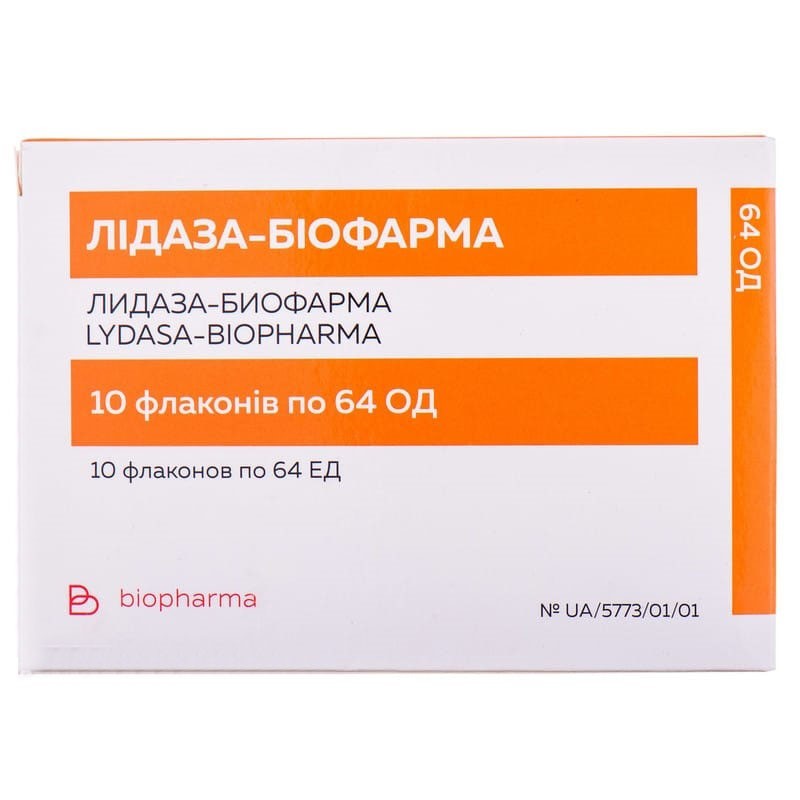



 Secure and encrypted payment processing
Secure and encrypted payment processing We ship to over 40 countries including the USA, UK, Europe, Australia and Japan
We ship to over 40 countries including the USA, UK, Europe, Australia and Japan Guaranteed refund or reship if you haven't received your order
Guaranteed refund or reship if you haven't received your orderhyaluronidase is an enzyme whose specific substrate is hyaluronic acid. the latter is a mucopolysaccharide, which consists of acetylglucosamine and glucuronic acid. hyaluronic acid has a high viscosity; biological value - "cementing" an intermediate substance of connective tissue. the effect of the drug is to improve joint mobility, soften scars, eliminate or reduce contractures, and resolve hematomas. the action is most pronounced in the initial stage of pathological processes. hyaluronidase (a propagation factor) causes the breakdown of hyaluronic acid to glucosamine and glucuronic acid and thereby leads to an increase in tissue permeability and an improvement in the movement of interstitial fluid. the effect of hyaluronidase is reversible - a decrease in concentration restores the viscosity of hyaluronic acid.
Pharmacokinetics Not studied.
Joint contractures, ankylosing spondylitis, dupuytren contracture (initial stage), cicatricial changes in the skin of various origins, hematomas, scleroderma. used in ophthalmology (keratitis, retinopathy), with pulmonary tuberculosis, with traumatic lesions of the nerve plexuses and peripheral nerves, with rheumatoid arthritis.
The drug lidase-biopharma is administered subcutaneously, under the scarred tissue, in / m, in the form of inhalations, by electrophoresis or applications on the mucous membranes. in ophthalmic practice, the drug can also be administered subconjunctival, retrobulbar.
For injection, the contents of the ampoule are dissolved in 1 ml of isotonic sodium chloride solution or in 1 ml of 0.5% Novocaine solution (procaine).
With contractures, scars of various origins, hematomas, ankylosing spondylitis, they are injected under the skin near the site of the lesion or under the scarred tissue to adults in a volume of 1 ml. Injections daily or every other day. The course of treatment is 6-10-15 injections.
In case of traumatic plexitis and similar lesions of the peripheral nerves, s / c is administered every other day to adults at a dose of 64 units in the Novocaine (procaine) solution. The course of treatment (12-15 injections) is repeated if necessary. In rheumatoid arthritis, the drug is used by electrophoresis: for adults, 64 units of lidase are dissolved in 30 ml of distilled water, 4–5 drops of 0.1 – N hydrochloric acid are added and introduced from the bifurcated electrode (anode) onto two joints. The duration of the procedure is 20-30 minutes, the course of treatment is 10-15 sessions.
With the productive nature of inflammation in patients with pulmonary tuberculosis, the drug is prescribed in the form of injections and inhalations in complex therapy in order to increase the concentration of antibiotics and other antibacterial agents in the lesion site. For inhalation, the contents of the ampoule are dissolved in 5 ml of isotonic sodium chloride solution. Inhalations daily 1 time per day (5 ml of a solution containing 64 units). The course requires 20–25 inhalations. Repeated courses - if necessary, at intervals of 1.5–2 months.
For finer scarring of the affected areas of the cornea with keratitis, the drug solution is instilled (1 ampoule with the drug is dissolved in 20 ml of isotonic sodium chloride solution or in 20 ml of 0.5% Novocaine solution (procaine)) with the use of antibiotics, sulfonamides.
With retinopathies, the drug is administered subcutaneously in the temporal region of 0.5 ml of solution (1 ampoule with the drug is dissolved in 20 ml of isotonic sodium chloride solution or in 20 ml of 0.5% Novocaine solution (procaine)). The course of treatment is 10-15 procedures.
Malignant neoplasms, pregnancy.
General reactions: dizziness, headache, weakness, fever, chills, sweating.
Allergic reactions: skin rash, itching, urticaria.
Local reactions: with i / m administration, a rash, hyperemia, itching, swelling, pain, a feeling of heat at the injection site are possible; in ophthalmic practice with the subconjunctival, retrobulbar method of application - edema, hyperemia of the eyelids, paraorbital area, facial skin, hyperemia of the sclera.
With recent hemorrhages, the drug is not used.
During pregnancy and breastfeeding. Clinical data on the effectiveness and safety of the drug during pregnancy and lactation are not available. The drug is contraindicated during pregnancy. During the treatment period, it is necessary to stop breastfeeding.
Children. There are no clinical data on the efficacy and safety of the drug in children.
Influence on the ability to drive vehicles or other mechanisms. Not investigated.
The drug accelerates the absorption of other drugs (local anesthetics, isotonic solution, muscle relaxants, etc.) with sc and intramuscular administration of the latter.
In case of drug overdose in case of allergic reactions should stop using the drug.
In a dry, dark place at a temperature of 8-15 ° C.